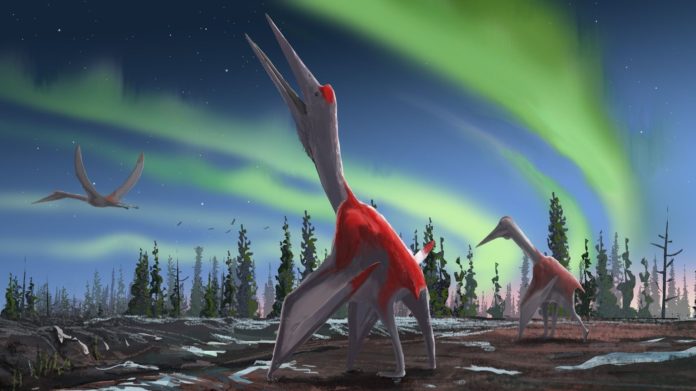Researchers believe they have discovered one of the biggest flying animals to have ever existed via fossilized remains found in Canada. The strange and monstrous creature, a type of pterosaur, weighed over 200 kilograms and lived around 77 million years ago.
The remarkably preserved specimen tells us a lot about its unique anatomy. Cryodrakon boreas, a name that translates to “frozen dragon of the north wind”, had a wingspan of up to 10 metres. That’s three times the wingspan of a wandering albatross, the current record holder.
It was also rather bizarre looking.
“They’re kind of built like a giraffe,” said lead author David Hone to NBC News. “If you stood next to a giraffe at a zoo and stretched its face about twice as long and bolted extra finger joints to its front legs, you’ve basically got it. They had huge heads, huge necks and long, wispy bodies covered in fine downy plumage like that seen on baby birds.”
Cryodrakon boreas‘s strange anatomy meant it was primarily composed of head and neck, and it would have searched around on land to hunt in spite of its massive wingspan. Food-wise, they probably favoured lizards, baby dinos, and small mammals.
Their ability to fly is believed by researchers to have been an escape mechanism, but they also think they may have been able to fly thousands of miles, covering large stretches of North America.
Discovery made after reassessing 30-year-old Alberta fossil
As fictitious as this creature may sound, it’s now officially been described as a distinct species.
Holotypes are a singular specimen upon which a new species’ name and description are based. For the Cryodrakon boreas, theirs was established using a specimen found around 30 years ago in Alberta’s Dinosaur Provincial Park, an area renowned worldwide as a source for dinosaur fossils.
Until recently, the running theory was that the remains were that of a quetzalcoatlus, a related pterosaur. However, after seeing the fossil for himself, the University of Southern California’s Michael Habib intuited it wasn’t quite as it seemed. The first clue was that the neck was long like that of a quetzalcoatlus, but the proportions didn’t correspond.
Enter Hone, a pterosaur expert from the Queen Mary University of London, who took the lead. Thanks to the specimen’s excellent state of preservation, several key areas were intact and open to study, including the legs, wings, the neck and ribs.
“This type of pterosaur is quite rare, and most specimens are just a single bone,” said Habib in a USC press release. “Our new species is represented by a partial skeleton. This tells us a great deal about the anatomy of these large flyers, how they flew, and how they lived.”
Researchers found multiple key differences in the shape of vertebrae, cervical bones and leg bones. However, it was only after an “extremely laborious” process of cross-referencing their findings with fossils sourced from Mongolia and France that they were able to confirm what they had was indeed unique.
“This particular group of pterosaurs includes the largest flying animals of all time,” says Habib. “Their anatomy holds important clues about the limits of animal flight and may be important in the future for biologically-inspired mechanical design for flight.”








































